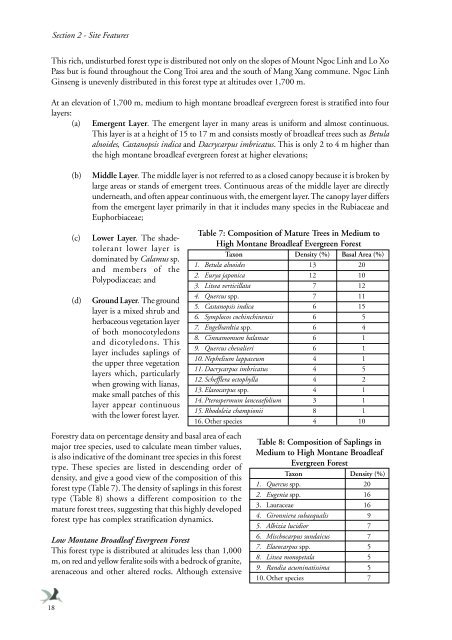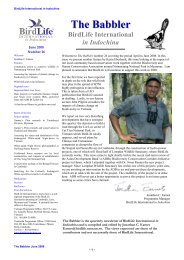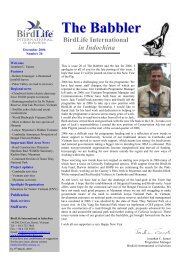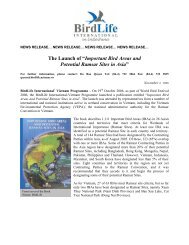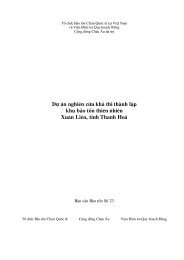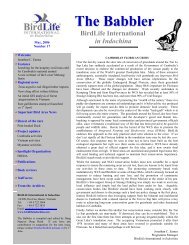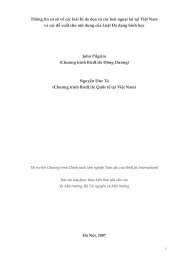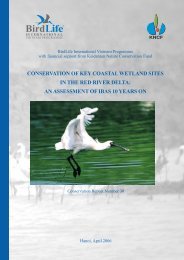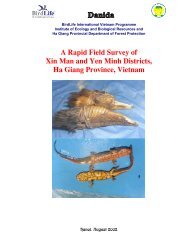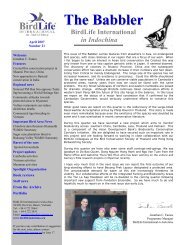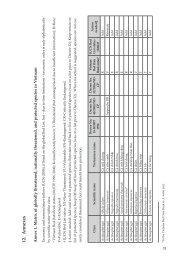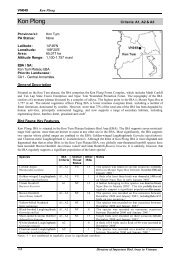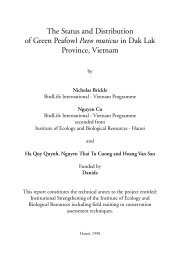An Investment Plan for Ngoc Linh Nature Reserve - Birdlife ...
An Investment Plan for Ngoc Linh Nature Reserve - Birdlife ...
An Investment Plan for Ngoc Linh Nature Reserve - Birdlife ...
You also want an ePaper? Increase the reach of your titles
YUMPU automatically turns print PDFs into web optimized ePapers that Google loves.
Section 2 - Site Features<br />
This rich, undisturbed <strong>for</strong>est type is distributed not only on the slopes of Mount <strong>Ngoc</strong> <strong>Linh</strong> and Lo Xo<br />
Pass but is found throughout the Cong Troi area and the south of Mang Xang commune. <strong>Ngoc</strong> <strong>Linh</strong><br />
Ginseng is unevenly distributed in this <strong>for</strong>est type at altitudes over 1,700 m.<br />
At an elevation of 1,700 m, medium to high montane broadleaf evergreen <strong>for</strong>est is stratified into four<br />
layers:<br />
(a) Emergent Layer. The emergent layer in many areas is uni<strong>for</strong>m and almost continuous.<br />
This layer is at a height of 15 to 17 m and consists mostly of broadleaf trees such as Betula<br />
alnoides, Castanopsis indica and Dacrycarpus imbricatus. This is only 2 to 4 m higher than<br />
the high montane broadleaf evergreen <strong>for</strong>est at higher elevations;<br />
18<br />
(b) Middle Layer. The middle layer is not referred to as a closed canopy because it is broken by<br />
large areas or stands of emergent trees. Continuous areas of the middle layer are directly<br />
underneath, and often appear continuous with, the emergent layer. The canopy layer differs<br />
from the emergent layer primarily in that it includes many species in the Rubiaceae and<br />
Euphorbiaceae;<br />
(c) Lower Layer. The shadetolerant<br />
lower layer is<br />
dominated by Calamus sp.<br />
and members of the<br />
Polypodiaceae; and<br />
(d) Ground Layer. The ground<br />
layer is a mixed shrub and<br />
herbaceous vegetation layer<br />
of both monocotyledons<br />
and dicotyledons. This<br />
layer includes saplings of<br />
the upper three vegetation<br />
layers which, particularly<br />
when growing with lianas,<br />
make small patches of this<br />
layer appear continuous<br />
with the lower <strong>for</strong>est layer.<br />
Forestry data on percentage density and basal area of each<br />
major tree species, used to calculate mean timber values,<br />
is also indicative of the dominant tree species in this <strong>for</strong>est<br />
type. These species are listed in descending order of<br />
density, and give a good view of the composition of this<br />
<strong>for</strong>est type (Table 7). The density of saplings in this <strong>for</strong>est<br />
type (Table 8) shows a different composition to the<br />
mature <strong>for</strong>est trees, suggesting that this highly developed<br />
<strong>for</strong>est type has complex stratification dynamics.<br />
Low Montane Broadleaf Evergreen Forest<br />
This <strong>for</strong>est type is distributed at altitudes less than 1,000<br />
m, on red and yellow feralite soils with a bedrock of granite,<br />
arenaceous and other altered rocks. Although extensive<br />
Table 7: Composition of Mature Trees in Medium to<br />
High Montane Broadleaf Evergreen Forest<br />
Taxon Density (%) Basal Area (%)<br />
1. Betula alnoides 13 20<br />
2. Eurya japonica 12 10<br />
3. Litsea verticillata 7 12<br />
4. Quercus spp. 7 11<br />
5. Castanopsis indica 6 15<br />
6. Symplocos cochinchinensis 6 5<br />
7. Engelhardtia spp. 6 4<br />
8. Cinnamomum balansae 6 1<br />
9. Quercus chevalieri 6 1<br />
10. Nephelium lappaceum 4 1<br />
11. Dacrycarpus imbricatus 4 5<br />
12. Schefflera octophylla 4 2<br />
13. Elaeocarpus spp. 4 1<br />
14. Pterospermum lanceaefolium 3 1<br />
15. Rhodoleia championii 8 1<br />
16. Other species 4 10<br />
Table 8: Composition of Saplings in<br />
Medium to High Montane Broadleaf<br />
Evergreen Forest<br />
Taxon Density (%)<br />
1. Quercus spp. 20<br />
2. Eugenia spp. 16<br />
3. Lauraceae 16<br />
4. Gironniera subaequalis 9<br />
5. Albizia lucidior 7<br />
6. Mischocarpus sundaicus 7<br />
7. Elaeocarpus spp. 5<br />
8. Litsea monopetala 5<br />
9. Randia acuminatissima 5<br />
10. Other species 7


